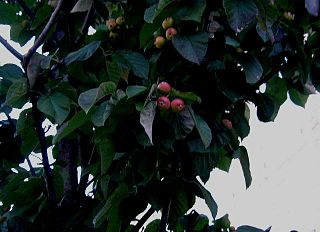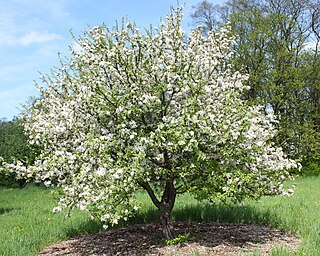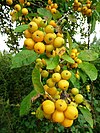
Malus is a genus of about 30–55 species of small deciduous trees or shrubs in the family Rosaceae, including the domesticated orchard apple, crab apples and wild apples.

Platycladus is a monotypic genus of evergreen coniferous trees in the cypress family Cupressaceae, containing only one species, Platycladus orientalis, also known as Chinese thuja, Oriental arborvitae, Chinese arborvitae, biota or Oriental thuja. It is native to northeastern parts of East Asia and North Asia, but is also now naturalised as an introduced species in other regions of the Asian continent.

Salix purpurea, the purple willow, purpleosier willow, or purple osier, is a species of willow native to most of Europe and western Asia north to the British Isles, Poland, and the Baltic States.

Malus sieversii is a wild apple native to the mountains of Central Asia in southern Kazakhstan. It has recently been shown to be the primary ancestor of most cultivars of the domesticated apple. It was first described as Pyrus sieversii due to its similarities with pears in 1833 by Carl Friedrich von Ledebour, a German naturalist who saw them growing in the Altai Mountains.

Juniperus squamata, the flaky juniper, or Himalayan juniper is a species of coniferous shrub in the cypress family Cupressaceae, native to the Himalayas and China.

Ligustrum lucidum, the broad-leaf privet, Chinese privet, glossy privet, tree privet or wax-leaf privet, is a species of flowering plant in the olive family Oleaceae, native to the southern half of China and naturalized in many places. The name "Chinese privet" is also used for Ligustrum sinense.

Macromeles tschonoskii is a species of flowering plant in the family Rosaceae. It is a tree endemic to Japan.

Malus floribunda, common name Japanese flowering crabapple, Japanese crab, purple chokeberry, or showy crabapple, originates from Japan and East Asia. It may be a hybrid of M. toringo with M. baccata, in which case it would be written as Malus × floribunda.
Ligustrum pricei is a species of Ligustrum, native to China and Taiwan, where it occurs at 900–1700 m altitude.

Sorbus hupehensis, also known as Hupeh rowan or Hubei rowan, is a species of rowan native to central and western China. It is found between Qinghai and Gansu in the west, Yunnan in the south, Jiangxi in the southeast, and Shandong in the east.

Malus angustifolia, or southern crabapple, is a species of crabapple native to the eastern and south-central United States.

Malus baccata is an Asian species of apple known by the common names Siberian crab apple, Siberian crab, Manchurian crab apple and Chinese crab apple. It is native to many parts of Asia, but is also grown elsewhere as an ornamental tree and for rootstock. It is used for bonsai. It bears plentiful, fragrant, white flowers and edible red to yellow fruit of about 1 cm diameter.

Malus prunifolia is a species of crabapple tree known by the common names plumleaf crab apple, plum-leaved apple, pear-leaf crabapple, Chinese apple and Chinese crabapple. It is native to China, and is grown elsewhere for use as an ornamental tree or as rootstock. It reaches from between 3 and 8 meters tall and bears white flowers and yellow or red fruit.

Malus sieboldii, commonly called Siebold's crab, Siebold's crabapple or Toringo crabapple, is a species of crabapple in the family Rosaceae.

Malus spectabilis is a species of crabapple known by the common names Asiatic apple, Chinese crab, HaiTang and Chinese flowering apple.

Malus transitoria, the cut-leaf crabapple, is a species of flowering plant in the crabapple genus Malus of the family Rosaceae, native to China.

Eriocapitella hupehensis, a species of flowering plant in the buttercup family Ranunculaceae, is native to Asia. The specific epithet hupehensis, which means "from Hupeh province, China", refers to a region where the species is known to occur. In Chinese, it is called dǎ pò wǎn huā huā (打破碗花花), which means "broken bowl flower".

Fraxinus hubeiensis is a species of ash native to Hubei province in China.
Pyrus hupehensis may refer to two different species of plants:



















